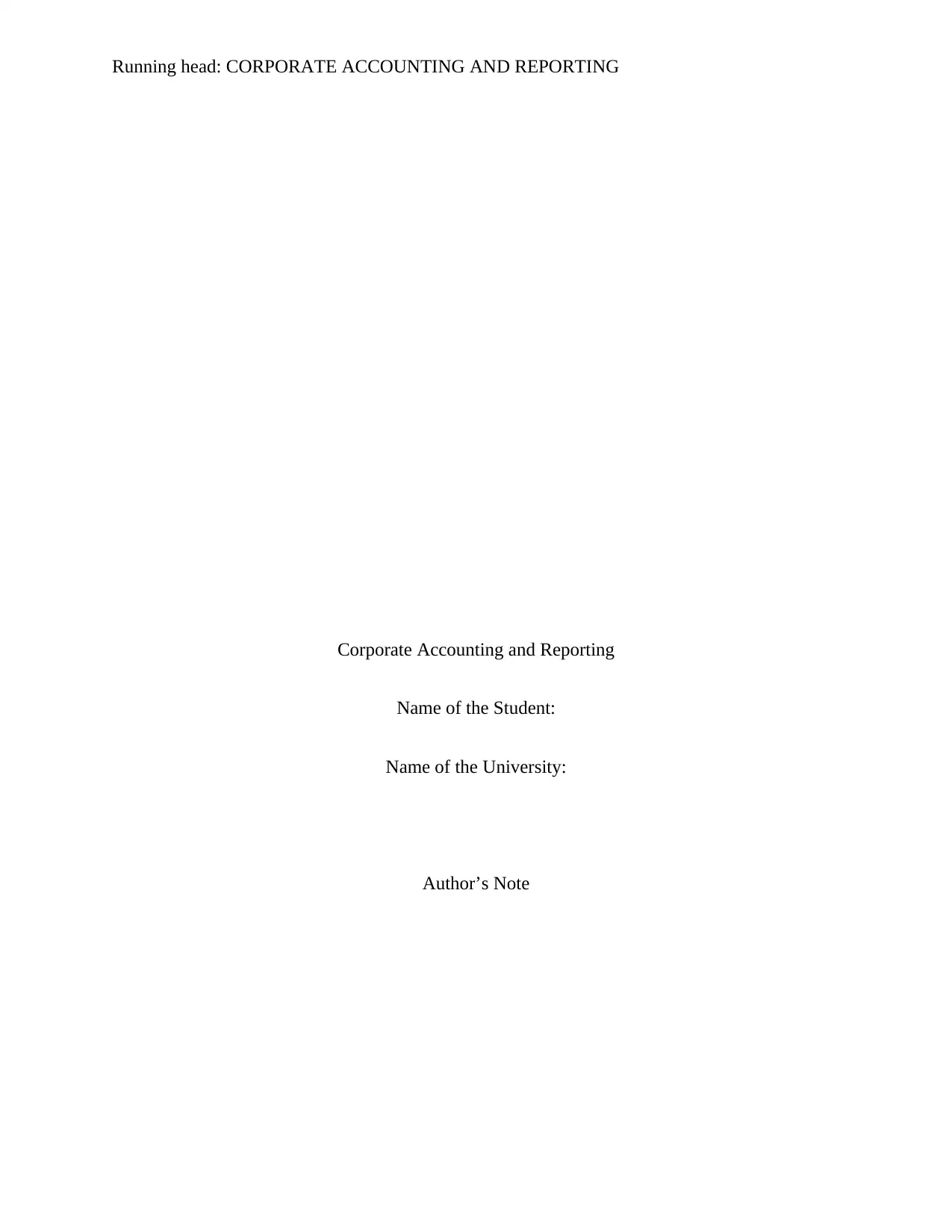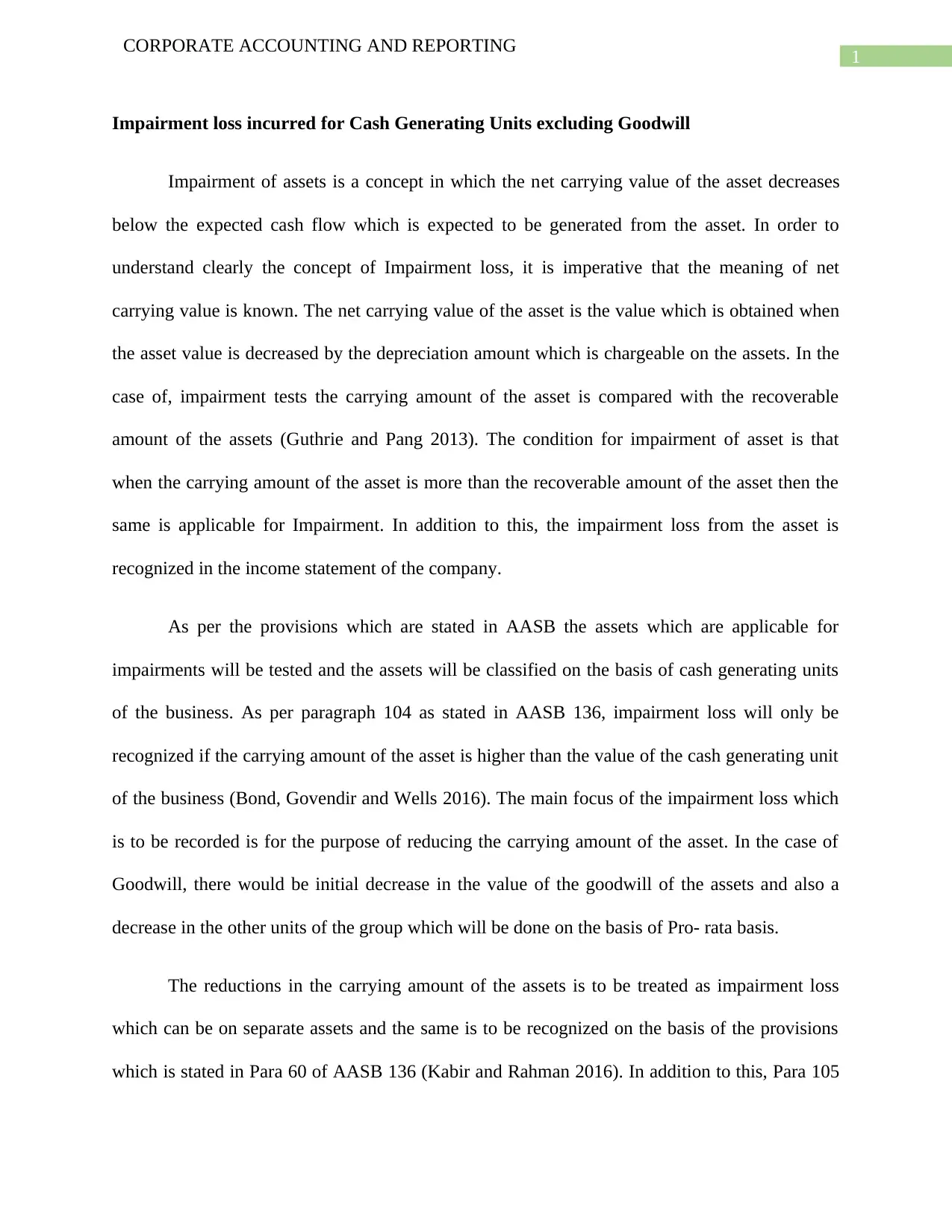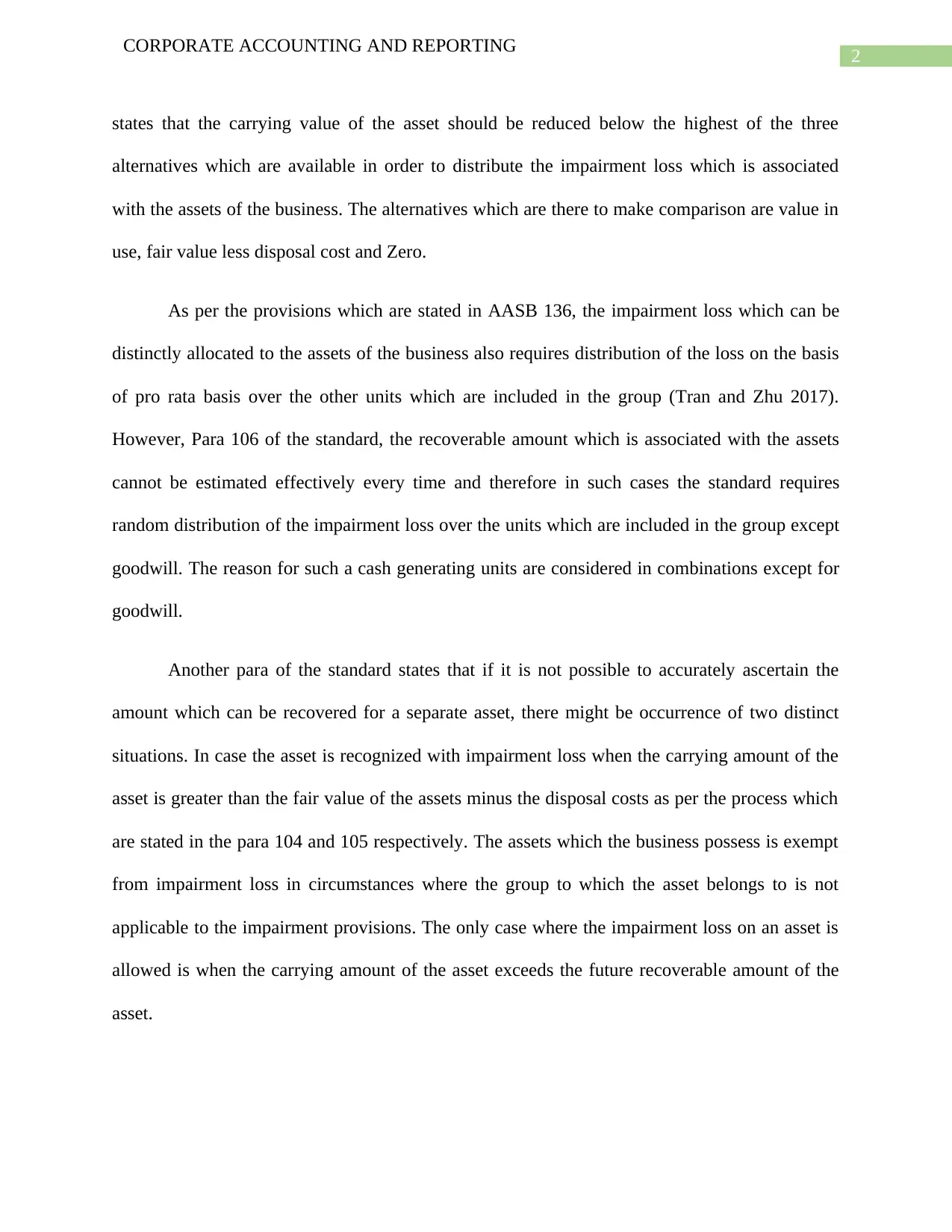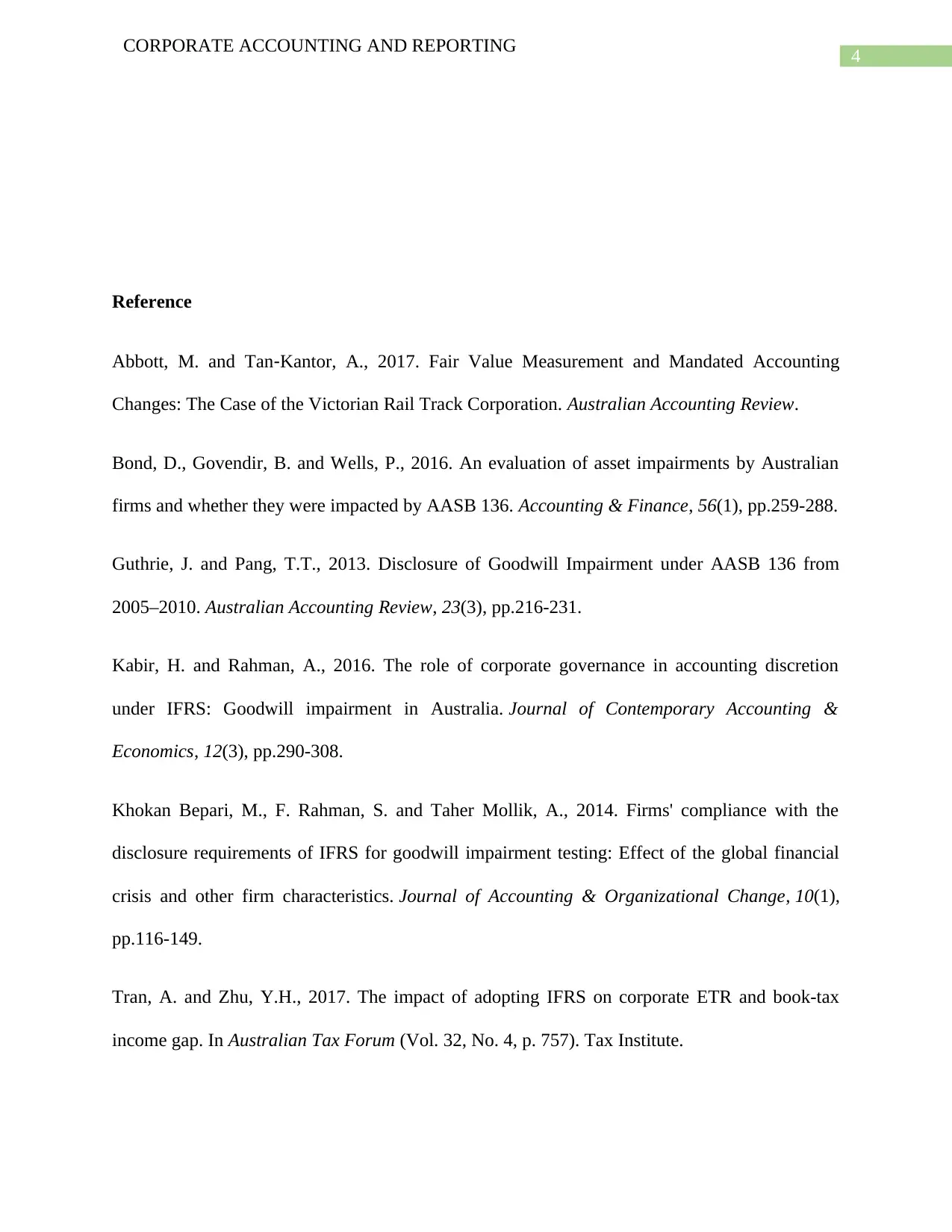Analyzing Impairment Loss on CGUs in Corporate Accounting & Reporting
VerifiedAdded on 2023/06/11
|5
|1359
|395
Essay
AI Summary
This essay provides a detailed analysis of impairment loss, particularly focusing on cash generating units (CGUs) excluding goodwill, within the context of corporate accounting and reporting standards, specifically AASB 136. It explains the concept of impairment, the calculation of net carrying value, and the conditions under which impairment losses are recognized. The essay further discusses the pro-rata distribution of impairment losses across CGUs, the exceptions for goodwill, and the practical challenges in estimating recoverable amounts. It uses the example of a damaged machine to illustrate the application of impairment principles and emphasizes the importance of accurate cash flow projections and management assumptions in determining impairment. The document references several academic sources to support its analysis and provide a comprehensive overview of the subject. Desklib offers a wide range of solved assignments and past papers for students.

Running head: CORPORATE ACCOUNTING AND REPORTING
Corporate Accounting and Reporting
Name of the Student:
Name of the University:
Author’s Note
Corporate Accounting and Reporting
Name of the Student:
Name of the University:
Author’s Note
Paraphrase This Document
Need a fresh take? Get an instant paraphrase of this document with our AI Paraphraser

1
CORPORATE ACCOUNTING AND REPORTING
Impairment loss incurred for Cash Generating Units excluding Goodwill
Impairment of assets is a concept in which the net carrying value of the asset decreases
below the expected cash flow which is expected to be generated from the asset. In order to
understand clearly the concept of Impairment loss, it is imperative that the meaning of net
carrying value is known. The net carrying value of the asset is the value which is obtained when
the asset value is decreased by the depreciation amount which is chargeable on the assets. In the
case of, impairment tests the carrying amount of the asset is compared with the recoverable
amount of the assets (Guthrie and Pang 2013). The condition for impairment of asset is that
when the carrying amount of the asset is more than the recoverable amount of the asset then the
same is applicable for Impairment. In addition to this, the impairment loss from the asset is
recognized in the income statement of the company.
As per the provisions which are stated in AASB the assets which are applicable for
impairments will be tested and the assets will be classified on the basis of cash generating units
of the business. As per paragraph 104 as stated in AASB 136, impairment loss will only be
recognized if the carrying amount of the asset is higher than the value of the cash generating unit
of the business (Bond, Govendir and Wells 2016). The main focus of the impairment loss which
is to be recorded is for the purpose of reducing the carrying amount of the asset. In the case of
Goodwill, there would be initial decrease in the value of the goodwill of the assets and also a
decrease in the other units of the group which will be done on the basis of Pro- rata basis.
The reductions in the carrying amount of the assets is to be treated as impairment loss
which can be on separate assets and the same is to be recognized on the basis of the provisions
which is stated in Para 60 of AASB 136 (Kabir and Rahman 2016). In addition to this, Para 105
CORPORATE ACCOUNTING AND REPORTING
Impairment loss incurred for Cash Generating Units excluding Goodwill
Impairment of assets is a concept in which the net carrying value of the asset decreases
below the expected cash flow which is expected to be generated from the asset. In order to
understand clearly the concept of Impairment loss, it is imperative that the meaning of net
carrying value is known. The net carrying value of the asset is the value which is obtained when
the asset value is decreased by the depreciation amount which is chargeable on the assets. In the
case of, impairment tests the carrying amount of the asset is compared with the recoverable
amount of the assets (Guthrie and Pang 2013). The condition for impairment of asset is that
when the carrying amount of the asset is more than the recoverable amount of the asset then the
same is applicable for Impairment. In addition to this, the impairment loss from the asset is
recognized in the income statement of the company.
As per the provisions which are stated in AASB the assets which are applicable for
impairments will be tested and the assets will be classified on the basis of cash generating units
of the business. As per paragraph 104 as stated in AASB 136, impairment loss will only be
recognized if the carrying amount of the asset is higher than the value of the cash generating unit
of the business (Bond, Govendir and Wells 2016). The main focus of the impairment loss which
is to be recorded is for the purpose of reducing the carrying amount of the asset. In the case of
Goodwill, there would be initial decrease in the value of the goodwill of the assets and also a
decrease in the other units of the group which will be done on the basis of Pro- rata basis.
The reductions in the carrying amount of the assets is to be treated as impairment loss
which can be on separate assets and the same is to be recognized on the basis of the provisions
which is stated in Para 60 of AASB 136 (Kabir and Rahman 2016). In addition to this, Para 105

2
CORPORATE ACCOUNTING AND REPORTING
states that the carrying value of the asset should be reduced below the highest of the three
alternatives which are available in order to distribute the impairment loss which is associated
with the assets of the business. The alternatives which are there to make comparison are value in
use, fair value less disposal cost and Zero.
As per the provisions which are stated in AASB 136, the impairment loss which can be
distinctly allocated to the assets of the business also requires distribution of the loss on the basis
of pro rata basis over the other units which are included in the group (Tran and Zhu 2017).
However, Para 106 of the standard, the recoverable amount which is associated with the assets
cannot be estimated effectively every time and therefore in such cases the standard requires
random distribution of the impairment loss over the units which are included in the group except
goodwill. The reason for such a cash generating units are considered in combinations except for
goodwill.
Another para of the standard states that if it is not possible to accurately ascertain the
amount which can be recovered for a separate asset, there might be occurrence of two distinct
situations. In case the asset is recognized with impairment loss when the carrying amount of the
asset is greater than the fair value of the assets minus the disposal costs as per the process which
are stated in the para 104 and 105 respectively. The assets which the business possess is exempt
from impairment loss in circumstances where the group to which the asset belongs to is not
applicable to the impairment provisions. The only case where the impairment loss on an asset is
allowed is when the carrying amount of the asset exceeds the future recoverable amount of the
asset.
CORPORATE ACCOUNTING AND REPORTING
states that the carrying value of the asset should be reduced below the highest of the three
alternatives which are available in order to distribute the impairment loss which is associated
with the assets of the business. The alternatives which are there to make comparison are value in
use, fair value less disposal cost and Zero.
As per the provisions which are stated in AASB 136, the impairment loss which can be
distinctly allocated to the assets of the business also requires distribution of the loss on the basis
of pro rata basis over the other units which are included in the group (Tran and Zhu 2017).
However, Para 106 of the standard, the recoverable amount which is associated with the assets
cannot be estimated effectively every time and therefore in such cases the standard requires
random distribution of the impairment loss over the units which are included in the group except
goodwill. The reason for such a cash generating units are considered in combinations except for
goodwill.
Another para of the standard states that if it is not possible to accurately ascertain the
amount which can be recovered for a separate asset, there might be occurrence of two distinct
situations. In case the asset is recognized with impairment loss when the carrying amount of the
asset is greater than the fair value of the assets minus the disposal costs as per the process which
are stated in the para 104 and 105 respectively. The assets which the business possess is exempt
from impairment loss in circumstances where the group to which the asset belongs to is not
applicable to the impairment provisions. The only case where the impairment loss on an asset is
allowed is when the carrying amount of the asset exceeds the future recoverable amount of the
asset.
⊘ This is a preview!⊘
Do you want full access?
Subscribe today to unlock all pages.

Trusted by 1+ million students worldwide

3
CORPORATE ACCOUNTING AND REPORTING
An example which can be given for impairment of asset is that of a machine which has
suffered physical damage, however it could be used in the production process (Khokan Bepari,
Rahman and Taher Mollik 2014). The only consideration is that the effectiveness of the asset
will be reduced due to the damaged to asset. The carrying amount of the asset will be considered
along with the recoverable amount of the asset so that effective impairment can be undertaken on
the assets of the company. if the carrying amount of the machine is more than the recoverable
amount which can be generated from the asset than the same is to be impaired as per the
provisions which are stated in AASB 136. In addition to this, the group to which the machine
belongs to will also be subjected to impairment which will be done on a pro rate basis (Abbott
and Tan‐Kantor 2017).
The assumptions which are taken for the purpose of estimating the impairment of the
assets of the business is related to the estimation of the current cash flow projections of the
business which will be based on the past cash flow projections and actual cash flow and the
management of a company also needs to check the consistency of the cash flow projects with
reference to past year’s cash flow projections of the business. The management also has to
formulate budgets which will be containing information that will be supporting the assumptions
and the estimates of the management about the economic conditions that will be existing over the
useful life of the asset.
Thus, from the above discussions, it can be clear that the impairment loss which is
attributable to the cash generating units, the distribution of the loss value is to be made among
the assets which form the part of the cash generating unit on the basis of Pro rata system. The
only thing to remember is that goodwill will not be included in the computation. Thus, the
impairment losses are recognized in the profit and loss account of the business.
CORPORATE ACCOUNTING AND REPORTING
An example which can be given for impairment of asset is that of a machine which has
suffered physical damage, however it could be used in the production process (Khokan Bepari,
Rahman and Taher Mollik 2014). The only consideration is that the effectiveness of the asset
will be reduced due to the damaged to asset. The carrying amount of the asset will be considered
along with the recoverable amount of the asset so that effective impairment can be undertaken on
the assets of the company. if the carrying amount of the machine is more than the recoverable
amount which can be generated from the asset than the same is to be impaired as per the
provisions which are stated in AASB 136. In addition to this, the group to which the machine
belongs to will also be subjected to impairment which will be done on a pro rate basis (Abbott
and Tan‐Kantor 2017).
The assumptions which are taken for the purpose of estimating the impairment of the
assets of the business is related to the estimation of the current cash flow projections of the
business which will be based on the past cash flow projections and actual cash flow and the
management of a company also needs to check the consistency of the cash flow projects with
reference to past year’s cash flow projections of the business. The management also has to
formulate budgets which will be containing information that will be supporting the assumptions
and the estimates of the management about the economic conditions that will be existing over the
useful life of the asset.
Thus, from the above discussions, it can be clear that the impairment loss which is
attributable to the cash generating units, the distribution of the loss value is to be made among
the assets which form the part of the cash generating unit on the basis of Pro rata system. The
only thing to remember is that goodwill will not be included in the computation. Thus, the
impairment losses are recognized in the profit and loss account of the business.
Paraphrase This Document
Need a fresh take? Get an instant paraphrase of this document with our AI Paraphraser

4
CORPORATE ACCOUNTING AND REPORTING
Reference
Abbott, M. and Tan‐Kantor, A., 2017. Fair Value Measurement and Mandated Accounting
Changes: The Case of the Victorian Rail Track Corporation. Australian Accounting Review.
Bond, D., Govendir, B. and Wells, P., 2016. An evaluation of asset impairments by Australian
firms and whether they were impacted by AASB 136. Accounting & Finance, 56(1), pp.259-288.
Guthrie, J. and Pang, T.T., 2013. Disclosure of Goodwill Impairment under AASB 136 from
2005–2010. Australian Accounting Review, 23(3), pp.216-231.
Kabir, H. and Rahman, A., 2016. The role of corporate governance in accounting discretion
under IFRS: Goodwill impairment in Australia. Journal of Contemporary Accounting &
Economics, 12(3), pp.290-308.
Khokan Bepari, M., F. Rahman, S. and Taher Mollik, A., 2014. Firms' compliance with the
disclosure requirements of IFRS for goodwill impairment testing: Effect of the global financial
crisis and other firm characteristics. Journal of Accounting & Organizational Change, 10(1),
pp.116-149.
Tran, A. and Zhu, Y.H., 2017. The impact of adopting IFRS on corporate ETR and book-tax
income gap. In Australian Tax Forum (Vol. 32, No. 4, p. 757). Tax Institute.
CORPORATE ACCOUNTING AND REPORTING
Reference
Abbott, M. and Tan‐Kantor, A., 2017. Fair Value Measurement and Mandated Accounting
Changes: The Case of the Victorian Rail Track Corporation. Australian Accounting Review.
Bond, D., Govendir, B. and Wells, P., 2016. An evaluation of asset impairments by Australian
firms and whether they were impacted by AASB 136. Accounting & Finance, 56(1), pp.259-288.
Guthrie, J. and Pang, T.T., 2013. Disclosure of Goodwill Impairment under AASB 136 from
2005–2010. Australian Accounting Review, 23(3), pp.216-231.
Kabir, H. and Rahman, A., 2016. The role of corporate governance in accounting discretion
under IFRS: Goodwill impairment in Australia. Journal of Contemporary Accounting &
Economics, 12(3), pp.290-308.
Khokan Bepari, M., F. Rahman, S. and Taher Mollik, A., 2014. Firms' compliance with the
disclosure requirements of IFRS for goodwill impairment testing: Effect of the global financial
crisis and other firm characteristics. Journal of Accounting & Organizational Change, 10(1),
pp.116-149.
Tran, A. and Zhu, Y.H., 2017. The impact of adopting IFRS on corporate ETR and book-tax
income gap. In Australian Tax Forum (Vol. 32, No. 4, p. 757). Tax Institute.
1 out of 5
Related Documents
Your All-in-One AI-Powered Toolkit for Academic Success.
+13062052269
info@desklib.com
Available 24*7 on WhatsApp / Email
![[object Object]](/_next/static/media/star-bottom.7253800d.svg)
Unlock your academic potential
Copyright © 2020–2025 A2Z Services. All Rights Reserved. Developed and managed by ZUCOL.



